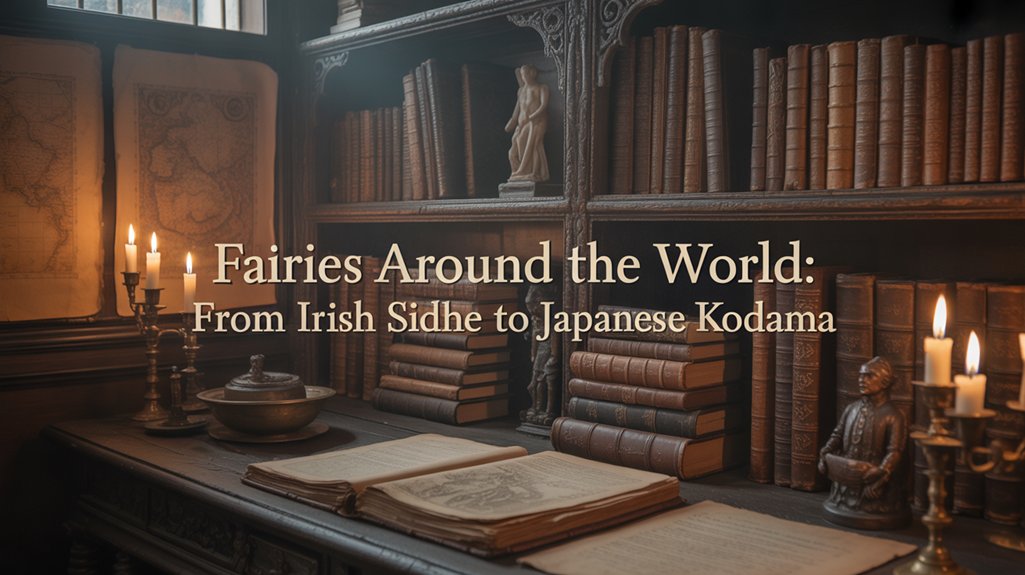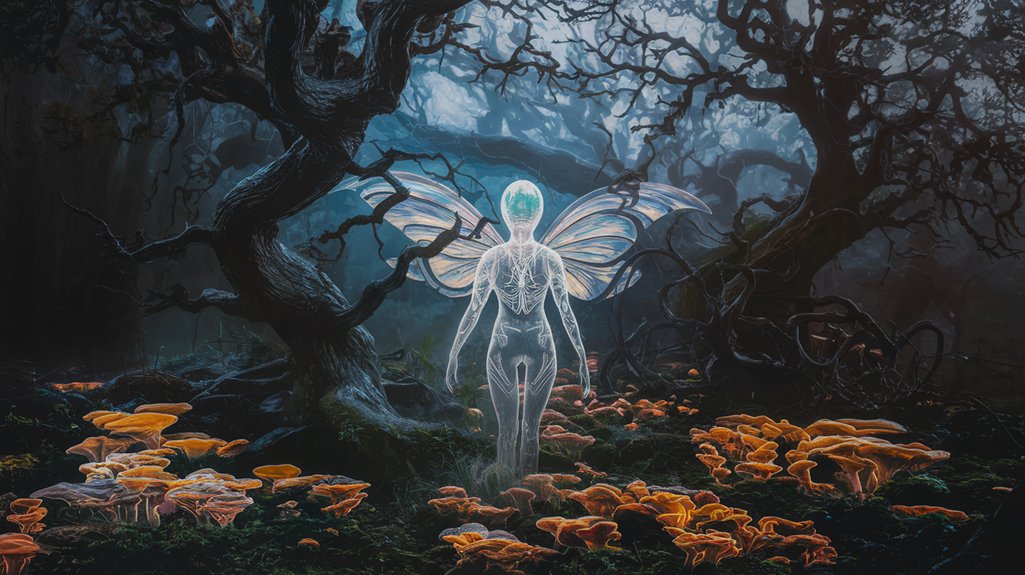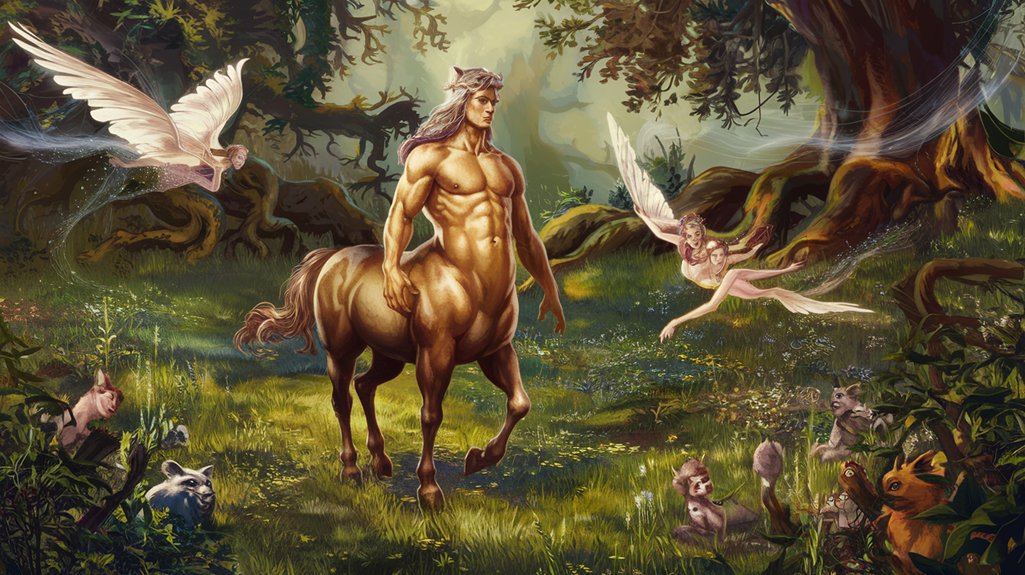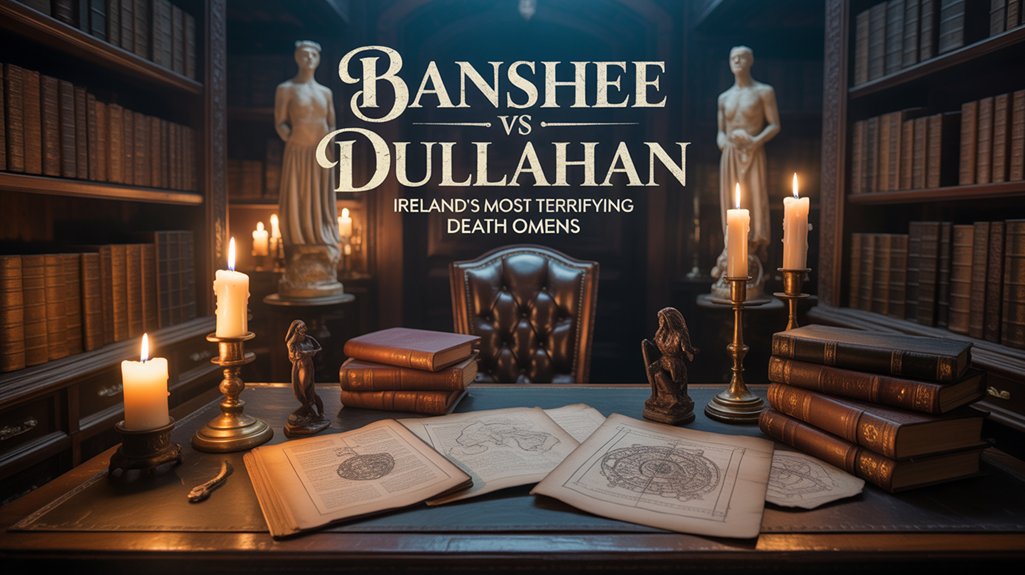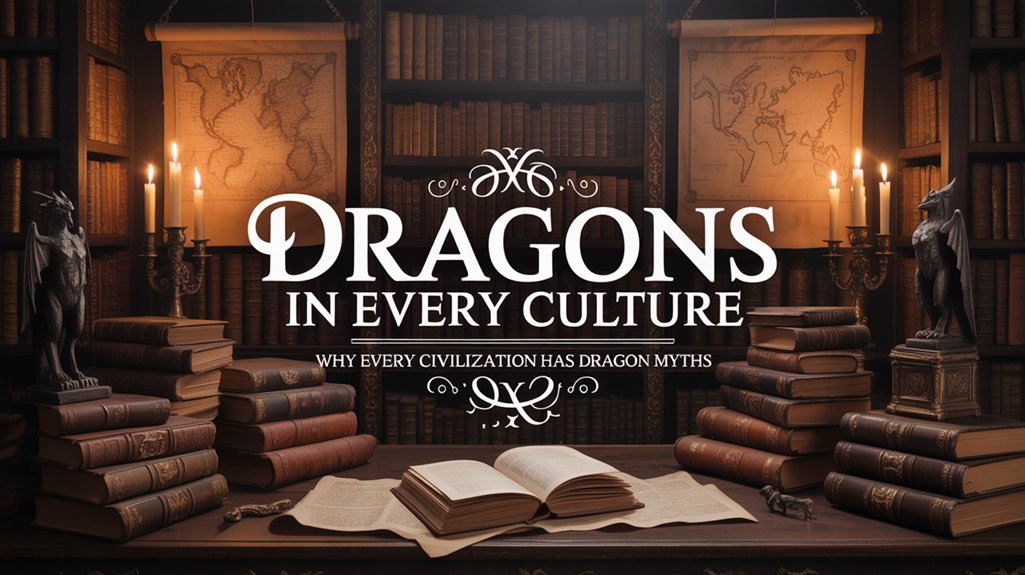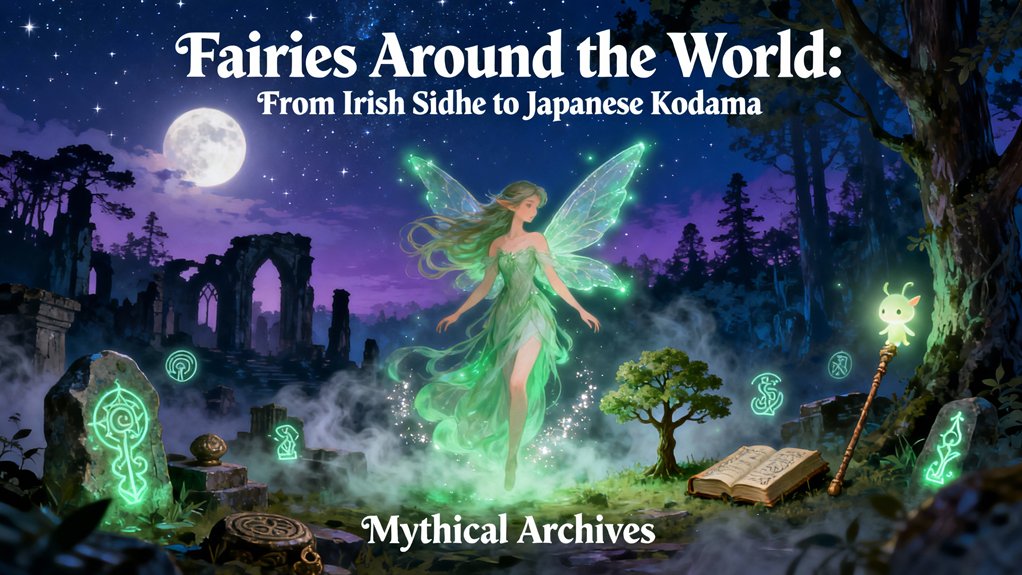
You’ll discover liminal beings across every continent—Ireland’s Sidhe dwelling beneath ancient burial mounds where time fractures, Japan’s luminescent Kodama binding their essence to sacred groves, Slavic Rusalki dancing beneath willows seeking vengeance for drowning deaths, Persian Peri weaving beauty to shorten their exile from grace, Norse Álfar oscillating between transcendence and shadow, and Latin American Duendes enforcing household morality through chimeric forms. Each tradition names these threshold-dwellers differently, yet their presence reveals universal truths about humanity’s relationship with the unseen, and the patterns connecting these entities illuminate something profound about liminality itself.
Table of Contents
ToggleKey Takeaways
- Celtic Sidhe are liminal beings dwelling in subterranean realms where time flows differently, trading with humans and demanding tribute.
- Japanese Kodama are tree spirits manifesting as luminous orbs in sacred groves, bringing misfortune if their host trees are harmed.
- Slavic Rusalki are water nymphs representing drowned women who lure men with songs, seeking vengeance for past betrayals and deaths.
- Persian Peri are fallen angels seeking redemption through creating beauty, existing between divine immortals and corrupted demons in Zoroastrian cosmology.
- Norse Álfar include Light Elves embodying transcendence and Dark Elves inhabiting shadows, oscillating between beneficence and malevolence toward humans.
The Celtic Sidhe: Beautiful, Dangerous, and Forever Beyond the Veil
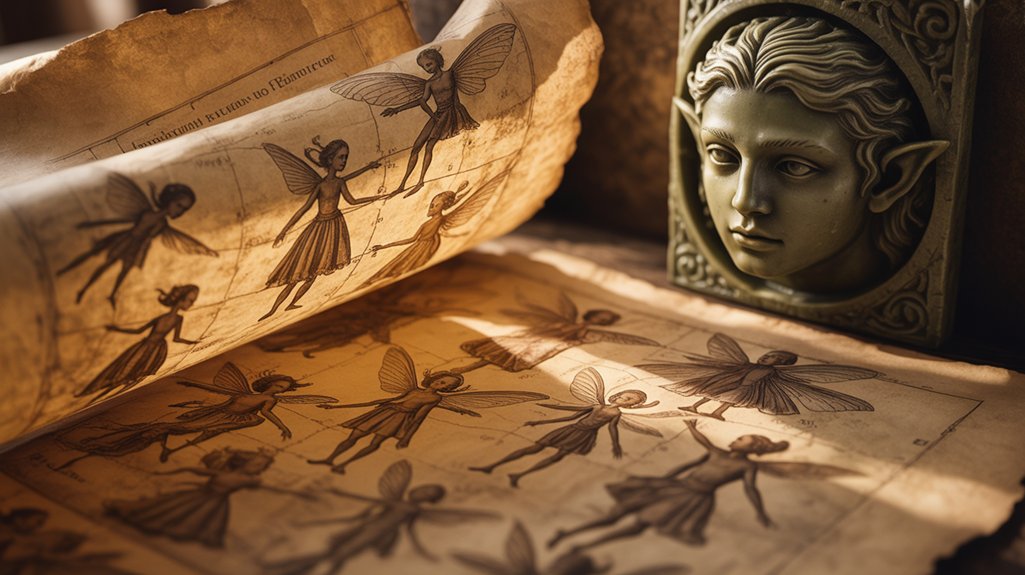
Though the modern imagination conjures delicate, gossamer-winged sprites when it speaks of fairies, the Celtic Sidhe (pronounced “shee”) emerge from Ireland’s primordial mists as something far more formidable—neither entirely spirit nor wholly flesh, but rather entities dwelling in the liminal threshold between dimensions.
The Sidhe transcend Victorian fairy tales—primordial beings haunting the threshold between worlds, neither spirit nor flesh, luminous and terrible.
You’ll discover in Celtic folklore that these beings aren’t diminutive garden ornaments but towering, luminous figures of eldritch beauty whose very presence warps mortal perception.
Sidhe legends preserve accounts of their subterranean kingdoms beneath ancient burial mounds, the sídhe themselves—those hollow hills where time flows differently, where a single night’s revelry costs you seven mortal years.
They’ve traded with humans, stolen children, and demanded tribute. They won’t forgive trespass.
Within their domain, you’d find courts of chimeric splendor: the Tuatha Dé Danann, Ireland’s old gods diminished yet unbroken, maintaining sovereignty beyond Christian conversion’s reach.
They demand respect, not worship. Cross them, and you’ll understand why your ancestors feared the Fair Folk.
These mythical creatures occupy a distinctive position within Celtic lore, their symbolic and cultural impact shaping Irish storytelling for millennia.
Kodama: Japan’s Tree Spirits and Guardians of Ancient Forests
In the ancient Shinto cosmology of Japan, where every mountain stream whispers with *kami* and venerable trees pulse with numinous presence, you encounter the kodama—those enigmatic spirits dwelling within sacred groves, their essences inseparable from the wood and bark that houses them.
These arboreal guardians, first documented in the *Kojiki* (712 CE) and *Nihon Shoki* (720 CE), manifest as luminescent orbs or faint echoes reverberating through primordial forests, their very existence contingent upon the trees’ survival.
You’ll find them altered in contemporary Japanese culture: from Hayao Miyazaki’s otherworldly forest spirits in *Princess Mononoke* (1997) to protective symbols in environmental movements, kodama bridge millennia of belief with startling continuity.
Origins in Shinto Belief
Long before Buddhist temples rose across the Japanese archipelago, the indigenous Shinto tradition recognized that certain ancient trees harbored sentient spirits—entities known as kodama, whose very existence blurred the boundary between the animate and inanimate.
Within Shinto mythology, you’ll discover a cosmology where rocks, waterfalls, and venerable trees possess consciousness, breathing life into landscapes Western rationalism declared inert. The spirit world wasn’t separate from physical reality—it interpenetrated every moss-covered bark, every gnarled root system.
These weren’t metaphors. Kodama represented actual presences dwelling within cryptomeria and camphor trees exceeding centuries of growth, their eldritch essences manifesting through unexplained echoes reverberating through mountain forests.
Cutting such trees invited catastrophic misfortune, divine retribution swift and merciless. You couldn’t simply exploit nature’s resources without acknowledging the sentient forces inhabiting them.
Kodama in Modern Culture
While ancient Shinto reverence for kodama might’ve faded under industrialization’s relentless march, Japan’s tree spirits experienced an unexpected renaissance through late twentieth-century popular culture—most notably through Hayao Miyazaki’s 1997 masterwork *Princess Mononoke*, which catapulted these enigmatic forest guardians into global consciousness.
Contemporary manifestations of kodama symbolism include:
- White, rattling-headed creatures whose clicking sounds evoke primordial forest communication
- Video game appearances establishing kodama in media as protective waypoints marking sacred groves
- Anime series depicting eldritch tree-dwellers as chimeric intermediaries between humanity’s technological appetite and nature’s diminishing sanctuaries
You’ll discover these spirits resonating with modern environmental consciousness, their presence reminding audiences that severing connections with ancient woodlands carries consequences.
Their revival speaks to collective yearning for restoration, equilibrium, freedom from ecological devastation.
Slavic Rusalki: Water Nymphs Between Vengeance and Tragedy
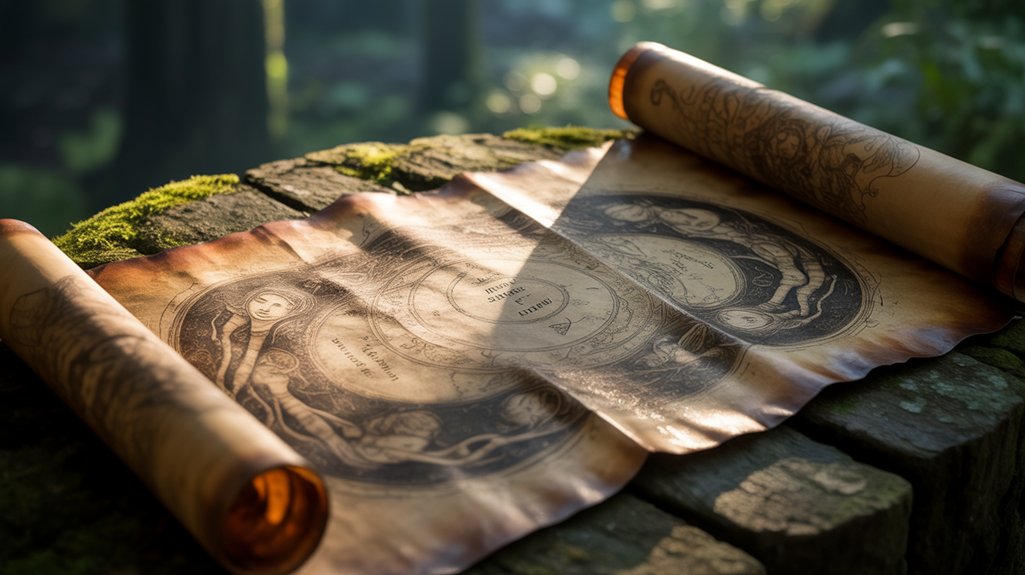
Across the moonlit rivers and misty lakes of Eastern Europe, the rusalki emerge as perhaps the most enigmatic and contradictory figures in Slavic folklore—spirits who embody simultaneously the allure of beauty and the terror of death.
These eldritch water nymphs, central to Rusalki myths spanning from medieval Rus’ to nineteenth-century villages, represent women who died by drowning—whether through suicide, murder, or tragic love gone wrong. They inhabit the liminal spaces where water symbolism merges with feminine vengeance, their pale forms dancing beneath willows during Rusalka Week each June.
Nature spirits bound to aquatic domains, they lure men into depths with haunting songs, exacting retribution for betrayals suffered in life.
Folklore interpretations vary: some scholars see them as chimeric remnants of pre-Christian water deities, others as cautionary figures embodying society’s anxieties about unbridled female sexuality and autonomy.
You’ll find them dwelling in that shadowed territory between victim and predator, forever caught between worlds.
Persian Peri: Fallen Angels Seeking Redemption Through Beauty
You’ll find the Persian peri occupying a singular theological position within Zoroastrian cosmology, where these luminous beings—neither wholly angelic nor completely demonic—exist as fallen entities expelled from paradise for transgressions against Ahura Mazda, the supreme deity of ancient Iran’s dualistic faith.
These chimeric spirits, documented in texts dating back to the Avesta (circa 1000 BCE), embody beauty so transcendent, so achingly ethereal, that their very appearance serves as both their punishment and their pathway to salvation.
Where Slavic rusalki channeled their anguish into vengeance, peri convert their exile into aesthetic devotion, each act of creating or protecting beauty functioning as penitential work, a spiritual labor that might, across centuries of corporeal manifestation, restore them to the divine domain they lost.
Origins in Zoroastrian Mythology
- Temporal origins: Third century BCE Avestan texts first codified *peri* mythology
- Cosmic positioning: Existed between *amesha spentas* (holy immortals) and corrupted *daevas* (demons)
- Redemptive trajectory: Their eldritch beauty served as both punishment and pathway toward reintegration
Beauty as Spiritual Salvation
Luminescence became the peri’s primary instrument of atonement, converting their cursed exile into a centuries-long spiritual labor. You’ll find these fallen angels perpetually manifesting their ethereal beauty as redemptive currency, each radiant gesture calculating divine forgiveness. Their transformative grace operates through material splendor: gardens blooming at their touch, celestial music emanating from their movements, eldritch light suffusing their presence.
| Redemptive Act | Spiritual Consequence |
|---|---|
| Creating beauty | Erasure of sin portions |
| Guiding mortals | Shortened exile duration |
| Protecting virtue | Raised angel status |
| Defeating divs | Paradise re-entry consideration |
| Inspiring poetry | Heavenly favor accumulation |
This chimeric existence—neither wholly damned nor saved—positions peris as liminal entities you might recognize: beauty incarnate, working toward salvation through aesthetic perfection itself. These luminous beings share conceptual space with deities from diverse mythologies, reminding us that redemption through beauty appears across cultural boundaries from Persian literature to the spiritual traditions documented in pantheons worldwide.
Norse Álfar: From Divine Ancestors to Mischievous Tricksters
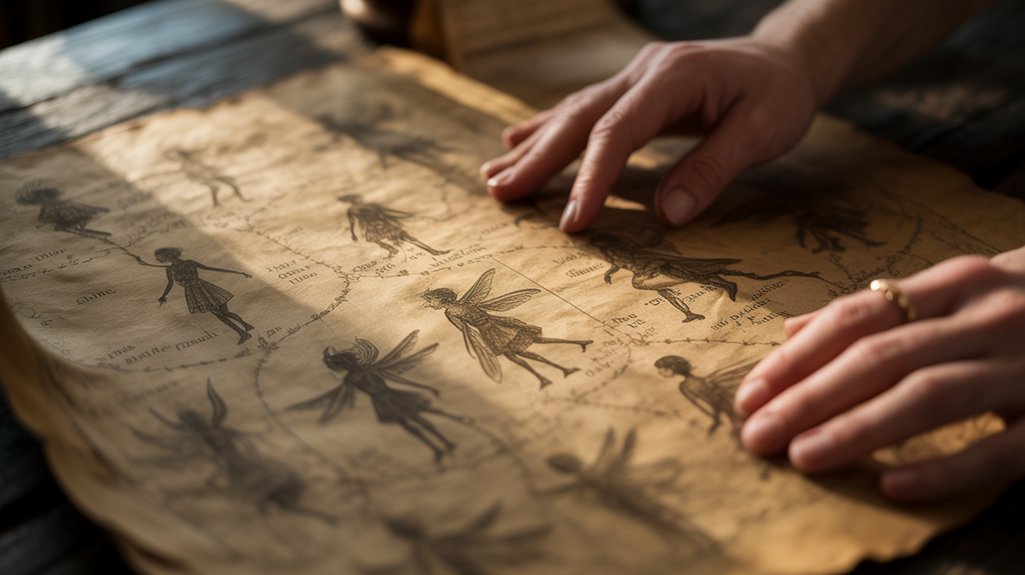
Before the Viking longships carved their serpentine paths across northern seas, the Álfar emerged from the cosmological mists of Germanic tradition as entities far more complex and potent than later folklore would suggest. In Norse mythology, these beings possessed divine ancestry, descended from primordial forces that shaped the nine dimensions themselves.
You’ll discover their dual nature—simultaneously benevolent guardians and capricious entities whose mischievous nature defied mortal comprehension.
The Álfar characteristics evolved dramatically across centuries:
- Ljósálfar (Light Elves) dwelt in Álfheimr, radiating eldritch luminescence, embodying spiritual symbolism of transcendence.
- Dökkálfar (Dark Elves) inhabited subterranean domains, their chimeric forms blending with shadow and stone.
Regional folklore variations changed them from semi-divine ancestors into the trickster archetype—shape-shifters who blurred boundaries between blessing and curse.
Their cultural significance permeated medieval Scandinavian consciousness. Offerings placated them. Diseases bore their names.
These weren’t diminutive sprites but formidable beings whose presence demanded reverence, their liminal essence forever oscillating between beneficence and malevolence.
Latin American Duendes: Household Spirits of Protection and Chaos
Where the Iberian Peninsula’s Catholic mysticism collided with Indigenous cosmologies and African spiritual traditions, the duende emerged—a household entity whose very name betrays its Arabic origins (*duen de casa*, “master of the house”) yet whose manifestation across Latin America defies singular definition.
You’ll find him haunting colonial haciendas from Mexico to Argentina, shifting between benevolent guardian and eldritch tormentor depending on your household’s moral standing.
Duende folklore alters him into chimeric forms: the three-foot gnome with reversed feet in Paraguay, the whistling shadow in Colombian kitchens, the child-stealing specter in Mexican household legends.
He rewards cleanliness with hidden coins. He punishes disrespect with misplaced keys, soured milk, inexplicable bruises.
This syncretic spirit embodies colonialism’s violent fusion—neither purely European brownie nor Indigenous nature guardian, but something birthed from cultural collision.
The duende demands acknowledgment. Propitiation through small offerings. He represents household sovereignty operating outside colonial authority’s reach.
Frequently Asked Questions
How Do Modern Fairy Sightings Compare Across Different Cultures Today?
You’ll find modern fairy sightings reveal striking cultural adaptations across continents.
In Iceland, eldritch *huldufólk* encounters still halt construction projects, while Japan’s *kodama* manifest through unexplained forest phenomena.
Western urban legends increasingly blend Celtic sidhe with New Age consciousness, creating chimeric interpretations.
Yet traditional communities—Irish countrysides, Scandinavian villages—report experiences mirroring ancestral accounts: luminous figures, temporal distortions, vanishing pathways.
You’re witnessing not diminishment but change, ancient patterns reasserting themselves through contemporary frameworks, proving these liminal beings adapt as fluidly as human perception itself.
Can Fairy Folklore Be Traced to a Common Ancient Origin?
You’ll find scholars divided on fairy mythical origins, yet remarkable cultural similarities emerge—independently.
Eldritch beings inhabiting threshold spaces. Guardian spirits of ancient groves. The chimeric blend of human and other world. These patterns transcend geography, suggesting either collective human psychology or genuine encounters with something liminal.
No single ancestral source exists; rather, you’re witnessing parallel evolution of belief systems responding to universal experiences: unexplained phenomena, nature’s mysteries, the numinous presence dwelling just beyond rational comprehension.
What Psychological Purposes Do Fairy Beliefs Serve in Human Societies?
You’ll find fairy beliefs serve profound psychological comfort, offering explanations for life’s inexplicable losses—vanished children, sudden illness, eldritch phenomena beyond mortal comprehension.
They anchor cultural identity, weaving communities through shared numinous experiences. These liminal beings guard boundaries between known and unknown. They provide agency in powerless moments. Control through ritual appeasement. Understanding through narrative frameworks.
The sidhe and kodama aren’t mere superstition—they’re psychological architecture, chimeric constructs helping you navigate existence’s terrifying uncertainties while preserving ancestral wisdom.
Are There Any Cultures That Have No Fairy or Spirit Traditions?
You’ll find no culture truly bereft of such enchantment. Like stars illuminating darkness, spirit symbolism emerges universally—though cultural variations alter its expression.
Even societies appearing devoid of fairy-lore harbor comparable entities: ancestral presences, nature guardians, liminal beings dwelling between worlds. The eldritch impulse transcends geography.
Whether Indonesian hantu, Polynesian atua, or Arctic tupilaq, humans consistently populate their landscapes with numinous others. This chimeric tapestry reveals fundamental truth: we’re drawn instinctively toward the unseen, crafting intermediaries between mortal and divine domains.
How Has Globalization Affected Traditional Fairy Beliefs in Indigenous Communities?
You’ll witness cultural exchange altering indigenous fairy traditions through internet documentation, tourism commodification, and syncretism with global New Age movements.
Belief evolution manifests paradoxically—while younger generations abandon ancestral practices, digital platforms preserve eldritch knowledge previously transmitted orally.
Remote communities face chimeric hybridization: Japanese kodama merge with Celtic aesthetics, Filipino diwata adopt Western fairy wings.
Yet resistance persists. Some indigenous keepers deliberately restrict sacred knowledge, maintaining liminal boundaries against homogenization’s relentless tide.
Conclusion
You’ve traversed ethereal boundaries, witnessing how disparate cultures perceive the Other—those liminal beings who’ve neither passed beyond nor remained wholly present. The Sidhe, Kodama, Rusalki, Peri, Álfar, and Duendes aren’t mere folklore; they’re humanity’s attempt to name what dwells between visible and invisible domains. These entities, whether benevolent guardians or vengeful spirits, reveal our ancestors’ profound understanding: that reality contains layers beyond mortal comprehension, where the eldritch persists, patient and eternal.

